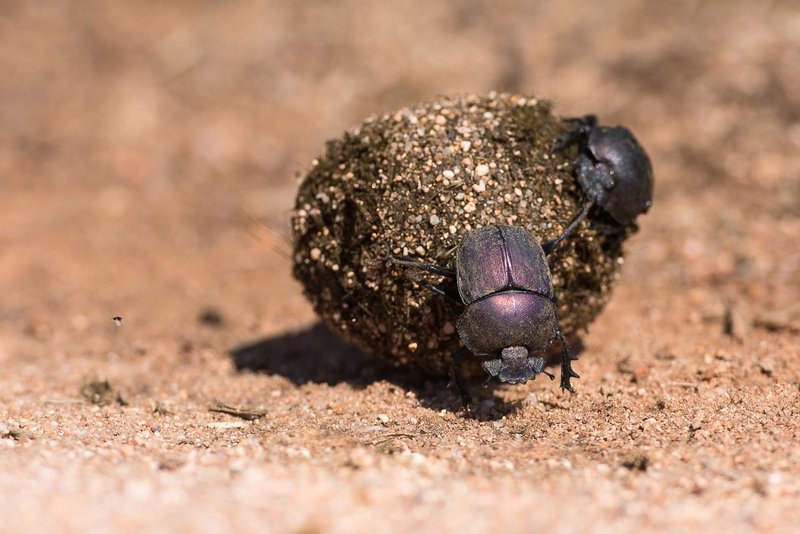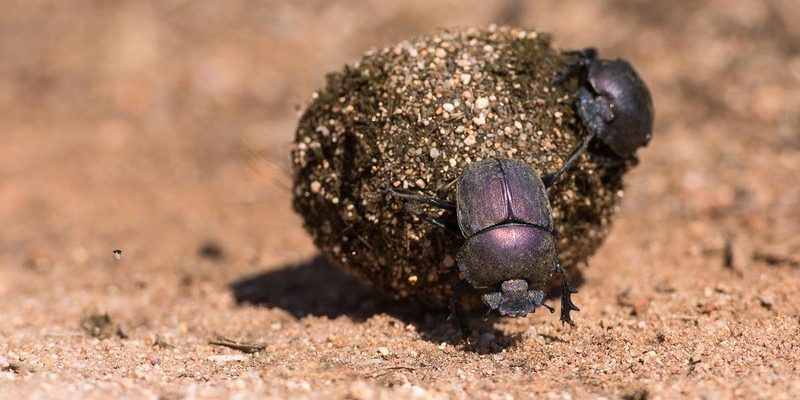
You might be surprised to know that dung beetles can be found all over the world—on nearly every continent except Antarctica. Their habitats vary widely, ranging from lush forests to open grasslands. They thrive in areas where animals roam because they depend on animal waste for food and reproduction. Here’s a closer look at their homes and the incredible ways they adapt to different environments.
Natural Habitats of Dung Beetles
Dung beetles are incredibly versatile and can inhabit a variety of environments. You can find them in places like:
- Tropical forests: These areas provide abundant organic material, including animal droppings, which dung beetles love.
- Grasslands: Here, herbivores like cows and deer drop plenty of waste, creating a buffet for dung beetles.
- Deserts: Believe it or not, some dung beetles have adapted to arid environments and can find moisture in animal dung.
- Urban areas: Some beetles have even made their home in cities, where they scavenge on pet waste.
Each habitat offers unique challenges and resources, and dung beetles have shown remarkable adaptability to thrive in these diverse conditions. In tropical forests, for instance, the dense vegetation and humidity create a rich ecosystem where dung beetles can easily find both food and shelter. In contrast, desert-dwelling beetles have developed traits to help them conserve water, proving how incredible their adaptations can be.
How Dung Beetles Find Food
Food is essential for dung beetles, as they primarily rely on animal feces as their main source of nourishment. They have an impressive sense of smell that helps them locate dung from great distances. Here’s how they do it:
1. Chemical Cues: Dung emits specific odors, and dung beetles can detect these scents with their keen antennae. This ability allows them to pinpoint fresh droppings quickly.
2. Location Preference: Different species of dung beetles have preferences for specific types of dung. Some may favor large mammals’ waste, while others might be more attracted to small animal droppings.
3. Competition and Cooperation: Dung beetles often work together in groups to access larger dung piles. They’ll roll and bury dung to prevent competition from others, ensuring they have enough to eat.
By utilizing their strong sense of smell and adapting to the types of dung available in their habitats, dung beetles can survive and thrive in various environments.
Adaptations for Survival
Dung beetles are highly adaptable, using a variety of strategies to survive in ever-changing environments. Here are a few key adaptations:
– Ball-Rolling Behavior: One of the most iconic behaviors is their ability to roll balls of dung away from the source. This not only helps them secure their food but also reduces competition from other beetles. It’s like taking your lunch to a quiet spot to enjoy it!
– Camouflage: Many dung beetles blend into their surroundings with earthy colors and textures. This helps them evade predators who might otherwise see them while they’re busy working.
– Burrowing: Some species dig burrows to store dung and lay their eggs. This provides both protection from predators and a steady food supply for their emerging larvae.
These adaptations are crucial in helping dung beetles navigate the challenges of their habitats, ensuring they continue to thrive.
The Role of Dung Beetles in the Ecosystem
You might be wondering why dung beetles matter so much. Well, they play a vital role in maintaining a healthy ecosystem. Here’s how:
– Nutrient Recycling: By breaking down dung, they help to recycle nutrients back into the soil. This process enriches the land, promoting healthy plant growth.
– Soil Aeration: As beetles burrow into the ground with dung, they aerate the soil, allowing water and nutrients to penetrate more easily. Think of them as nature’s little gardeners!
– Pest Control: Dung beetles help control the population of parasites found in feces, which benefits both animals and humans. Fewer parasites lead to healthier livestock and wildlife.
With this remarkable ability to improve soil health and control pests, dung beetles are unsung heroes in our ecosystems.
Behavioral Adaptations in Dung Beetles
The behaviors of dung beetles are just as fascinating as their physical adaptations. Here’s a closer look at some of their unique behaviors:
– Social Structures: Some dung beetle species are solitary, while others exhibit social behavior. In communal species, they may work together to roll and bury dung, increasing their chances of success.
– Mating Rituals: Male dung beetles often compete for females, showcasing their strength by rolling larger dung balls. This behavior not only helps them find a mate but also demonstrates their fitness as potential fathers.
– Nest Building: After burying dung, female beetles lay their eggs inside the dung ball. This provides a food source for the larvae once they hatch, showcasing a smart form of parental care.
These behavioral adaptations highlight the intricate social dynamics and survival strategies of dung beetles, making them even more intriguing.
Conservation of Dung Beetles
Despite their importance, dung beetles face threats from habitat loss, pesticides, and climate change. Conservation efforts are vital to ensure their survival and the health of our ecosystems. Here’s what can be done:
1. Habitat Protection: Preserving grasslands and forests helps maintain dung beetle populations. Creating wildlife reserves can provide safe spaces for them to thrive.
2. Sustainable Practices: Reducing pesticide use and promoting sustainable agriculture can help protect dung beetles and other beneficial insects.
3. Public Awareness: Educating communities about the importance of dung beetles can encourage conservation efforts. The more people know, the more likely they are to support efforts to protect these important creatures.
By taking action to conserve dung beetles, we can help maintain the balance of our ecosystems and ensure these remarkable creatures continue to play their vital roles.
Final Thoughts on Dung Beetles
Dung beetles are far more than just the quirky little bugs that roll poop around. They’re essential players in the health of our ecosystems, and their adaptations showcase nature’s incredible ingenuity. Whether they’re rolling dung in tropical forests or burrowing in grasslands, these beetles demonstrate a remarkable ability to thrive in a variety of environments.
So, the next time you come across a dung beetle in your backyard or on a nature walk, take a moment to appreciate the important work they do. They may be small, but their impact on our world is anything but insignificant.

